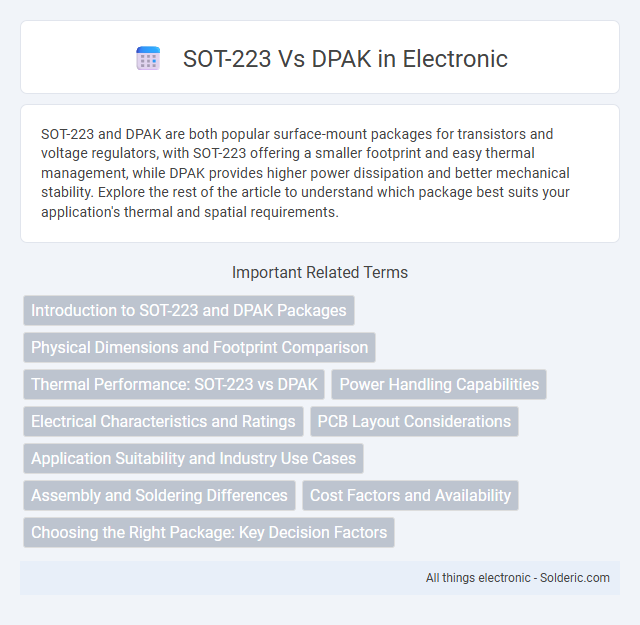SOT-223 and DPAK are both popular surface-mount packages for transistors and voltage regulators, with SOT-223 offering a smaller footprint and easy thermal management, while DPAK provides higher power dissipation and better mechanical stability. Explore the rest of the article to understand which package best suits your application's thermal and spatial requirements.
Comparison Table
| Feature | SOT-223 | DPAK |
|---|---|---|
| Package Type | Surface-mount transistor package | Surface-mount power transistor package |
| Typical Power Dissipation | Up to 2W (depending on PCB design) | Up to 30W (with heatsink) |
| Thermal Resistance (Junction-to-Ambient) | ~62degC/W | ~25degC/W |
| Package Size | Approx. 6.5 x 3.7 x 1.5 mm | Approx. 6.5 x 6.5 x 2.3 mm |
| Pin Count | 3 pins | 3 pins |
| Main Application | Low to medium power transistors and regulators | High power transistors, MOSFETs, and regulators |
| Mounting Style | Surface mount | Surface mount with enhanced heat dissipation |
Introduction to SOT-223 and DPAK Packages
SOT-223 and DPAK are widely used surface-mount transistor packages designed to facilitate efficient heat dissipation and reliable electrical performance in power applications. SOT-223 features a compact footprint with a flat heat sink tab, supporting moderate power handling and ease of PCB layout. DPAK, also known as TO-252, offers a larger thermal pad and higher current capacity, making it suitable for higher power semiconductor devices in automotive and industrial circuits.
Physical Dimensions and Footprint Comparison
SOT-223 packages typically measure around 6.7 mm x 3.7 mm with a smaller footprint, making them ideal for space-constrained PCB layouts. DPAK packages are larger, approximately 10 mm x 6.5 mm, offering greater power dissipation but requiring more board area. Selecting between SOT-223 and DPAK depends on your design's physical size constraints and thermal management requirements.
Thermal Performance: SOT-223 vs DPAK
The SOT-223 package offers improved thermal performance compared to the DPAK due to its larger copper area and enhanced heat dissipation capabilities, enabling more efficient cooling during high-power operation. Your designs benefit from lower junction-to-ambient thermal resistance in SOT-223, which helps maintain device reliability under demanding thermal conditions. While DPAK is well-suited for moderate power applications, SOT-223 is preferable when superior thermal management is critical.
Power Handling Capabilities
SOT-223 packages provide moderate power dissipation typically around 1.5 to 2 watts, suitable for low to medium power applications. DPAK (TO-252) offers higher power handling capabilities, often exceeding 3 to 5 watts due to larger thermal pads and enhanced heat dissipation through PCB mounting. Effective thermal management in DPAK supports higher current ratings and better reliability under elevated temperature conditions compared to SOT-223.
Electrical Characteristics and Ratings
SOT-223 packages typically offer lower power dissipation, around 1.5W to 2W, while DPAK packages support higher dissipation levels up to 3W or more, making DPAK suitable for applications requiring better heat management. The thermal resistance junction-to-ambient (RthJA) is generally lower in DPAK, enhancing reliability under high current conditions. Voltage and current ratings vary by specific device but DPAK often accommodates higher maximum current ratings compared to SOT-223, supporting more robust electrical performance in power applications.
PCB Layout Considerations
SOT-223 packages offer a compact footprint with a wide thermal pad that facilitates efficient heat dissipation on PCB layouts, making them ideal for moderate power applications. DPAK packages require larger copper areas and thermal vias to enhance thermal conductivity and maintain device reliability under high power loads. Proper PCB layout must consider pad size, thermal relief patterns, and solder mask openings to optimize electrical performance and thermal management for both SOT-223 and DPAK components.
Application Suitability and Industry Use Cases
SOT-223 packaging offers compact size and efficient heat dissipation, making it ideal for consumer electronics and portable devices requiring moderate power handling and thermal management. DPAK, with its robust thermal performance and larger footprint, suits high-power applications in automotive systems, industrial equipment, and power management circuits. Both packages support surface-mount technology but differ in power ratings and heat dissipation capabilities, dictating their selection based on specific industry needs and application requirements.
Assembly and Soldering Differences
SOT-223 packages feature a single exposed pad for heat dissipation, enabling straightforward soldering with a larger thermal pad area that improves heat transfer during assembly. DPAK packages include multiple leads and a larger tab, requiring precise placement and soldering techniques to ensure reliable thermal and electrical connections on the PCB. Your choice impacts the assembly process, with SOT-223 offering simpler soldering, while DPAK demands more meticulous handling due to its lead arrangement and mounting orientation.
Cost Factors and Availability
SOT-223 packages generally offer lower manufacturing costs due to their simpler design and widespread availability in bulk quantities, making them ideal for high-volume applications. DPAK components tend to be priced higher because of their robust construction and superior heat dissipation capabilities, which also affects their availability, often being preferred in power electronics requiring reliable thermal performance. Market trends show SOT-223 parts are more easily sourced from multiple suppliers, whereas DPAK devices may face limited availability due to specialized use cases and higher demand in niche segments.
Choosing the Right Package: Key Decision Factors
SOT-223 and DPAK packages differ mainly in thermal performance, size, and mounting style, crucial factors when selecting the right component for your PCB design. SOT-223 offers a compact footprint with moderate power dissipation, ideal for space-constrained applications, while DPAK provides enhanced heat sinking capabilities suitable for higher power requirements. Your choice depends on balancing thermal management needs against available board space and assembly preferences to ensure optimal device performance.
SOT-223 vs DPAK Infographic

 solderic.com
solderic.com